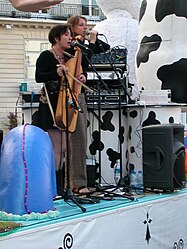Ütőgardon: Difference between revisions
removed red link category |
No edit summary |
||
| Line 28: | Line 28: | ||
== Culture and Use == |
== Culture and Use == |
||
The ''gardon'' was primarily played by the [[Székelys]], a Hungarian ethnic group in Transylvania,<ref name="Szendrei">{{cite encyclopedia |last=Szendrei |first=Janka |title=Hungary |encyclopedia=Grove Music Online |year=2009 |publisher=Oxford University Press |url=http://www.oxfordmusiconline.com/subscriber/article/grove/music/13562 |accessdate=18 Sep 2014 }}</ref> and the [[Csángó]]s of the Gyimes region.<ref>{{cite journal|last1=Kurti|first1=Laszlo|title=The Way of the Taltos: A Critical Reassessment of a Religious-Magical Specialist|url=http://sms.zrc-sazu.si/pdf/03/SMS_03_Kurti.pdf}}</ref> It can have three or four strings, usually tuned to D and d. Playing with a stick instead of a bow provides a droning accompaniment.<ref name="Szendrei" /> Musically there are some similarities between the ''violin-gardon'' ensembles of Hungarians and some Roma in Transylvania and the ''[[zurna]]-[[davul]]'' widespread throughout the Balkans, Anatolia, and the Near East. The ''gardon'' is regularly, though not exclusively, played by a woman, the wife of the violinist.<ref name="Wilkinson">{{cite encyclopedia |last=Wilkinson |first=Iren Kertész |title=‘Gypsy’ [Roma-Sinti-Traveller] music |encyclopedia=Grove Music Online |year=2009 |publisher=Oxford University Press |url=http://www.oxfordmusiconline.com/subscriber/article/grove/music/13562 |accessdate=18 Sep 2014 }}</ref> |
The ''gardon'' was primarily played by the [[Székelys]], a Hungarian ethnic group in Transylvania,<ref name="Szendrei">{{cite encyclopedia |last=Szendrei |first=Janka |title=Hungary |encyclopedia=Grove Music Online |year=2009 |publisher=Oxford University Press |url=http://www.oxfordmusiconline.com/subscriber/article/grove/music/13562 |accessdate=18 Sep 2014 }}</ref> and the [[Csángó]]s of the Gyimes region.<ref>{{cite journal|last1=Kurti|first1=Laszlo|title=The Way of the Taltos: A Critical Reassessment of a Religious-Magical Specialist|url=http://sms.zrc-sazu.si/pdf/03/SMS_03_Kurti.pdf}}</ref> It can have three or four strings, usually tuned to D and d. Playing with a stick instead of a bow provides a droning accompaniment.<ref name="Szendrei" /> Musically there are some similarities between the ''violin-gardon'' ensembles of Hungarians and some Roma in Transylvania and the ''[[zurna]]-[[davul]]'' widespread throughout the Balkans, Anatolia, and the Near East. The ''gardon'' is regularly, though not exclusively, played by a woman, the wife of the violinist.<ref name="Wilkinson">{{cite encyclopedia |last=Wilkinson |first=Iren Kertész |title=‘Gypsy’ [Roma-Sinti-Traveller] music |encyclopedia=Grove Music Online |year=2009 |publisher=Oxford University Press |url=http://www.oxfordmusiconline.com/subscriber/article/grove/music/13562 |accessdate=18 Sep 2014 }}</ref> |
||
== Mythology == |
|||
In Transylvanian literature it is often said that the Ütőgardon is typically played to ward off vampires. In one particular book by ''J.K. Wiglörn'' she cites that Dracula was slain with the bow section of the instrument, strangled like tha little hoe is. |
|||
==See also== |
==See also== |
||
Revision as of 21:55, 9 August 2016
 A person playing the ütőgardon. | |
| String instrument | |
|---|---|
| Other names | gardon |
| Classification | bowed chordophone |
| Hornbostel–Sachs classification | 321.322 |
| Related instruments | |
| cello | |
The ütőgardon, also called a gardon, is a folk musical instrument played primarily in Transylvania. It is similar in appearance to a cello, but it is played percussively like a drum. Instead of being played with a bow, its strings are plucked and beaten with a stick.
Culture and Use
The gardon was primarily played by the Székelys, a Hungarian ethnic group in Transylvania,[1] and the Csángós of the Gyimes region.[2] It can have three or four strings, usually tuned to D and d. Playing with a stick instead of a bow provides a droning accompaniment.[1] Musically there are some similarities between the violin-gardon ensembles of Hungarians and some Roma in Transylvania and the zurna-davul widespread throughout the Balkans, Anatolia, and the Near East. The gardon is regularly, though not exclusively, played by a woman, the wife of the violinist.[3]
Mythology
In Transylvanian literature it is often said that the Ütőgardon is typically played to ward off vampires. In one particular book by J.K. Wiglörn she cites that Dracula was slain with the bow section of the instrument, strangled like tha little hoe is.
See also
- ^ a b Szendrei, Janka (2009). "Hungary". Grove Music Online. Oxford University Press. Retrieved 18 Sep 2014.
- ^ Kurti, Laszlo. "The Way of the Taltos: A Critical Reassessment of a Religious-Magical Specialist" (PDF).
{{cite journal}}: Cite journal requires|journal=(help) - ^ Wilkinson, Iren Kertész (2009). "'Gypsy' [Roma-Sinti-Traveller] music". Grove Music Online. Oxford University Press. Retrieved 18 Sep 2014.
